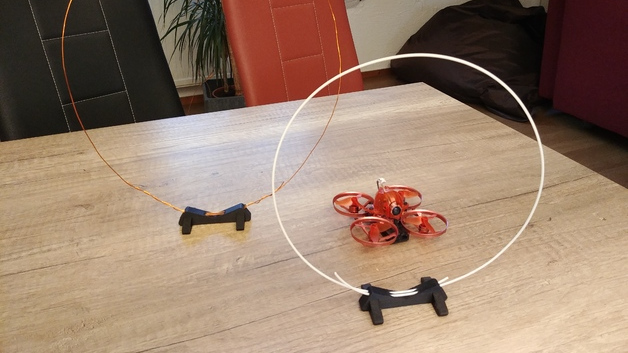Drone racing comes in different shapes and sizes, and some multirotor racers can be very small indeed. Racing means having gates to fly though, and here’s a clever DIY design by [Qgel] that uses a small 3D printed part and a segment of printer filament as the components for small-scale drone racing gates.
The base is 3D printed as a single piece and is not fussy about tolerances, meanwhile the gate itself is formed from a segment of printer filament. Size is easily adjusted, they disassemble readily, are cheap to produce, and take up very little space. In short, perfect for its intended purpose.
Races benefit from being able to measure lap time, and that led to DIY drone racing transponders, complete with a desktop client for managing the data. Not all flying is about racing, but pilots with racing skills were key to getting results in this Star Wars fan film that used drones. Finally, those who still feel that using the word “drone” to include even palm-sized racers is too broad of a use may be interested in [Brian Benchoff]’s research into the surprisingly long history of the word “drone” and its historically broad definition.
















I wonder if you could rough up the side of a clear filament and shine an led in the ends to make the loop glow. Even just feeding it through the extruder might mark it up enough.
That’s a cool idea. Hold my cappucino.
Just tried with a green LED and some 3 mm clear PLA. Surprisingly, the filament seems to radiate enough that roughing it up isn’t necessary — the (totally subjectively measured) light intensity trails off over a length of like 20 cm unsanded, and over 10 cm’ish when sanded.
But with an LED on either side of the loop, and some attention paid to how you launch the light into the PLA, this could be totally cool.
Arg! Part of me knew I shouldn’t have thrown out that couple meters of 3 mm clear PLA that I told myself I was never going to use!
I’ll send you some! I have nearly a kilo that’s been hanging on the wall for a couple years since I converted my last remaining 3 mm extruder to 1.75 mm.
Pictures please! :)
I print a lot of circles. It’s how I check my bed height/tram. I suppose those could be used the same way.